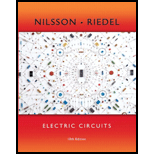
Concept explainers
a.
Calculate the fundamental frequency
a.
Answer to Problem 1P
The fundamental frequency
Explanation of Solution
Calculation:
Consider that the expression for the fundamental frequency
Substitute
Substitute
Conclusion:
Thus, the fundamental frequency
b.
Calculate the frequency
b.
Answer to Problem 1P
The fundamental frequency
Explanation of Solution
Calculation:
Consider that the expression for the frequency
Substitute
Substitute
Conclusion:
Thus, the fundamental frequency
c.
Calculate the Fourier co-efficient
c.
Answer to Problem 1P
The Fourier co-efficient
Explanation of Solution
Calculation:
Calculate the Fourier co-efficient
For the periodic voltage in part (b), the Fourier co-efficient
Conclusion:
Thus, the Fourier co-efficient
d.
Calculate the Fourier co-efficients
d.
Answer to Problem 1P
The Fourier co-efficients
Explanation of Solution
Calculation:
Consider that the periodic function in Figure P16.1(a). The Fourier co-efficient
Calculate the Fourier co-efficient
Calculate the Fourier co-efficient
Consider that the periodic function in Figure P16.1(b). The Fourier co-efficient
Calculate the Fourier co-efficient
Calculate the Fourier co-efficient
The value of
Conclusion:
Thus, the Fourier co-efficients
e.
Derive the Fourier series expression for the voltage
e.
Answer to Problem 1P
The Fourier series expression of voltage
Explanation of Solution
Calculation:
Write the Fourier series expression of voltage
Write the Fourier series expression of voltage
Conclusion:
Thus, the Fourier series expression of voltage
Want to see more full solutions like this?
Chapter 16 Solutions
Electric Circuits (10th Edition)
- Q3arrow_forwardGiven the logic function F(A,B,C,D) = Σm(1,2,3,4,9,10,11,12) (i) Write the truth table of the logic function. (ii) Use the Karnaugh-map method to find the simplest sum-of-products (SOP) expression of function F. (iii) Implement the minimized function with NAND gates only. (iv) Show that the Boolean function F can be constructed using exclusive-OR gates (v) Express the same logic function in a product-of-sums (POS) form. (vi) Simplify your function in product-of-sums (POS). (vii) Use a decoder with external AND gates only to implement F in its product-of- sums (POS) form (assume AND gates with any number of inputs are available). Note: You can use NAND gates with any number of inputs you may need. Assume, as well, that the input variables are available in both true and complemented form.arrow_forwardProblem A medical research facility is developing a proton accelerator for cancer treatment using proton therapy. The accelerator is designed to generate a beam of protons that precisely targets and destroys cancerous cells while minimizing damage to surrounding healthy tissue. However, there is an issue with the beam trajectory, which deviates from the intended direction when subjected to electric and magnetic fields. A team of engineers has been assigned to diagnose and resolve this issue. -The accelerator generates a beam of 10" protons with an initial velocity of v = 3 × 10° m/s in the y-axis direction. -An electric field of E = 200 kV/m is applied in the negative z-axis using a set of electrodes. -A magnetic field of B = 0.1T is applied along the z-axis using a solenoid to redirect the protons. - However, the beam does not align with the expected trajectory, indicating an error in field configuration or an unaccounted force acting on the protons. Answer the following questions 1.…arrow_forward
- Design a synchronous binary up-counter using 4 negative edge-triggered JK flip-flops provided with a clock. The states (sequences) 1100, 1001 and 1000 are considered as unused states. (i) Draw the state diagram of the counter. (ii) Build the counter's state table showing the synchronous inputs of the JK flip- flops as well. (iii) Using Karnaugh-maps, find the minimal sum-of-products (SOP) form of the equations for the inputs to the flip-flops; assume the next states of the unused combinations to be "don't care states”. (iv) Draw the logic circuit of the counter.arrow_forwardDesign a synchronous sequential circuit with two T flip-flops A and B, one input y and one output Z. When y = 0, the state of the circuit remains the same and Z= 0. When y = 1, the circuit goes through the following state transitions from 00 to 01 to 11 to 10 and back to 00, then repeats, while Z = y for states 10 and 11 and Z = y for states 00 and 01. Assume that state 00 is in the initial state. Provide a table that shows: the input and output values the states (present and next) for the two T flip-flops (i) (a) (b) (ii) (iii) Draw the resulting logic circuit. Using Karnaugh-maps, find the minimal sum-of-products (SOP) form of the equations for the inputs to the T flip-flops and the output (Z).arrow_forwardDesign a modulo-5 ripple (asynchronous) down-counter with D flip-flops and draw the corresponding logic circuit. (i) Build the state diagram and extract the state table(ii)Draw the logic circuit(iii) What is the maximum modulus of the counter?arrow_forward
 Introductory Circuit Analysis (13th Edition)Electrical EngineeringISBN:9780133923605Author:Robert L. BoylestadPublisher:PEARSON
Introductory Circuit Analysis (13th Edition)Electrical EngineeringISBN:9780133923605Author:Robert L. BoylestadPublisher:PEARSON Delmar's Standard Textbook Of ElectricityElectrical EngineeringISBN:9781337900348Author:Stephen L. HermanPublisher:Cengage Learning
Delmar's Standard Textbook Of ElectricityElectrical EngineeringISBN:9781337900348Author:Stephen L. HermanPublisher:Cengage Learning Programmable Logic ControllersElectrical EngineeringISBN:9780073373843Author:Frank D. PetruzellaPublisher:McGraw-Hill Education
Programmable Logic ControllersElectrical EngineeringISBN:9780073373843Author:Frank D. PetruzellaPublisher:McGraw-Hill Education Fundamentals of Electric CircuitsElectrical EngineeringISBN:9780078028229Author:Charles K Alexander, Matthew SadikuPublisher:McGraw-Hill Education
Fundamentals of Electric CircuitsElectrical EngineeringISBN:9780078028229Author:Charles K Alexander, Matthew SadikuPublisher:McGraw-Hill Education Electric Circuits. (11th Edition)Electrical EngineeringISBN:9780134746968Author:James W. Nilsson, Susan RiedelPublisher:PEARSON
Electric Circuits. (11th Edition)Electrical EngineeringISBN:9780134746968Author:James W. Nilsson, Susan RiedelPublisher:PEARSON Engineering ElectromagneticsElectrical EngineeringISBN:9780078028151Author:Hayt, William H. (william Hart), Jr, BUCK, John A.Publisher:Mcgraw-hill Education,
Engineering ElectromagneticsElectrical EngineeringISBN:9780078028151Author:Hayt, William H. (william Hart), Jr, BUCK, John A.Publisher:Mcgraw-hill Education,





